This website may contain affiliate links and advertising so that we can provide recipes to you. Read my disclosure policy.
This rich, flavorful homemade beef broth is slow-simmered from roasted bones, vegetables, and herbs for lots of flavor. It’s perfect for soups, sauces, or sipping straight from a mug!
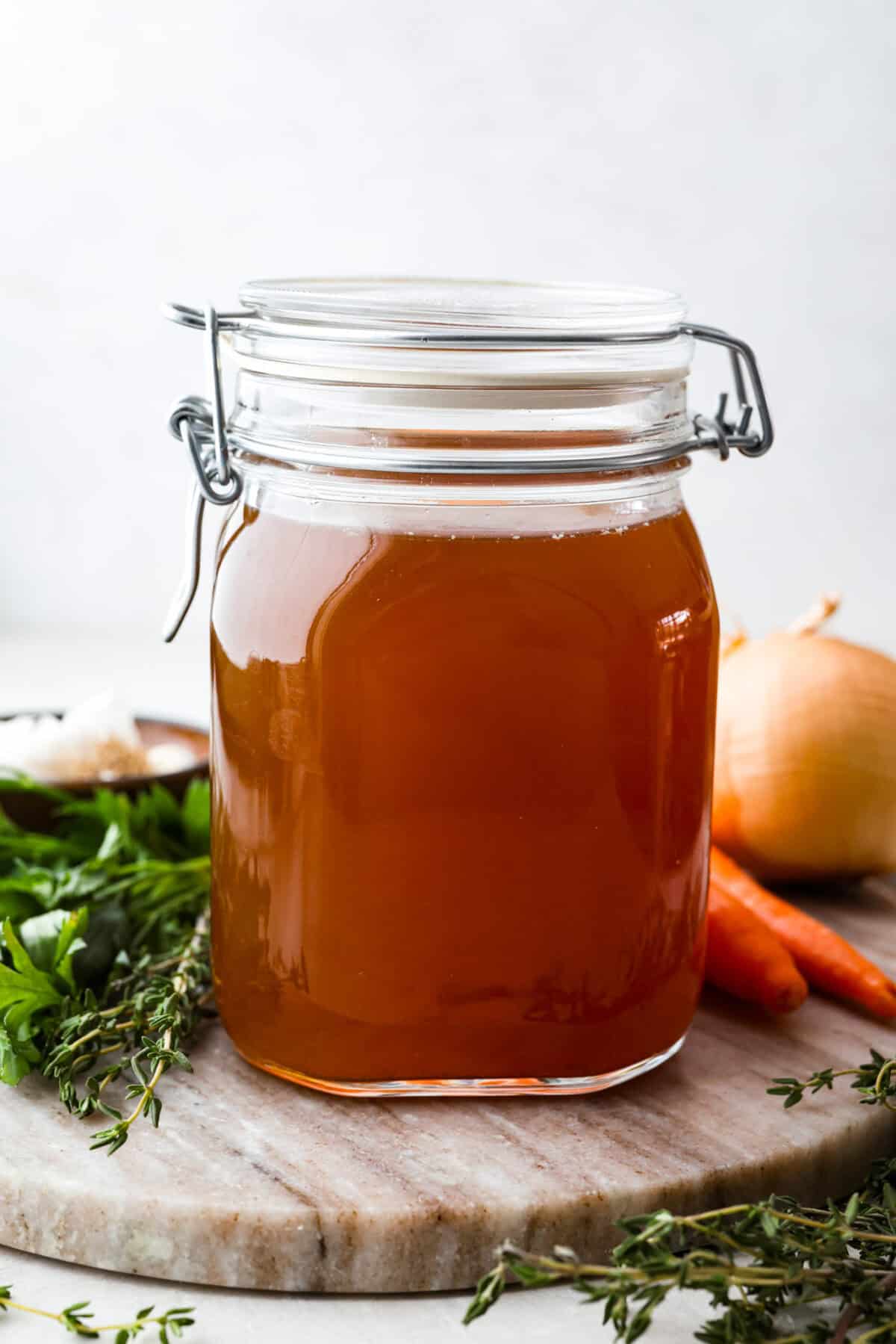
Here’s Why It Beats Store-Bought
- Pure, rich flavor. Slow-simmered bones create a rich, deep flavor you’ll never get from a box.
- Clean and wholesome. No mystery ingredients, just real, simple goodness.
- Budget-friendly magic. Turns leftover bones and veggies into liquid gold.
- Make it your way. Control the salt, intensity, and aromatics to suit your taste.
Homemade Beef Broth Ingredients
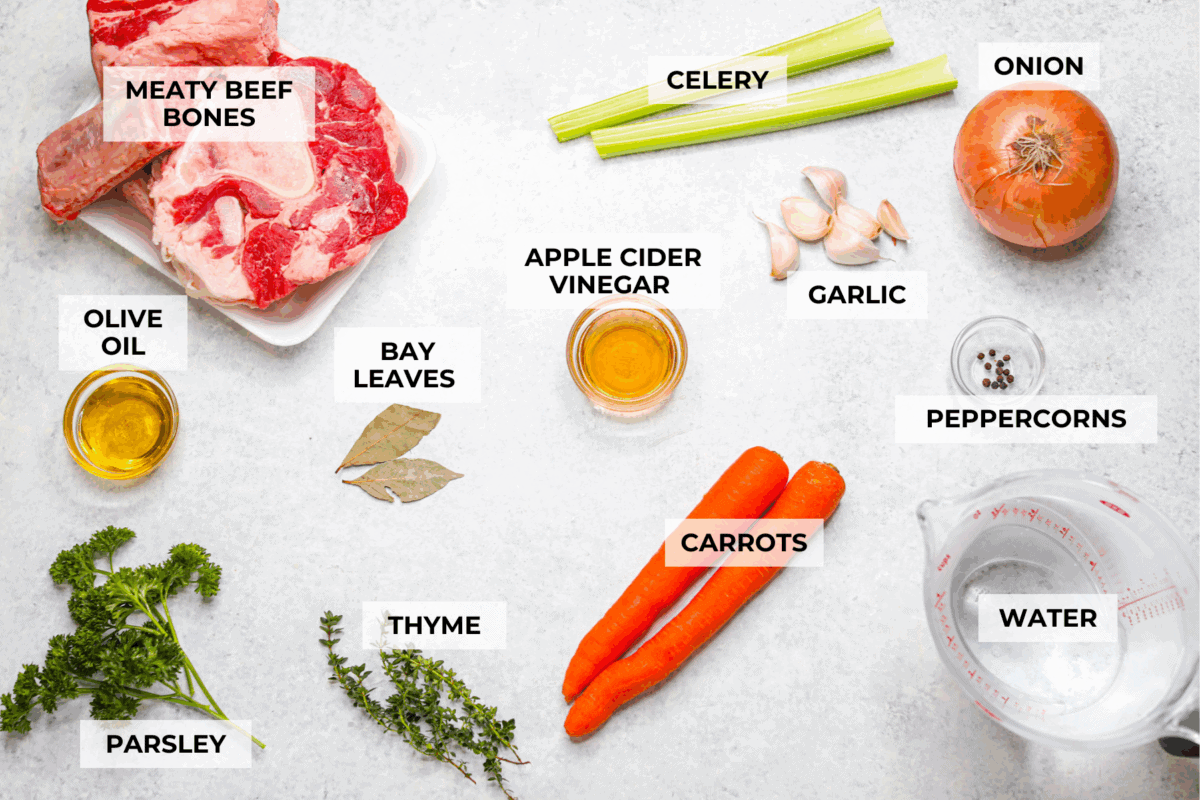
- Choosing and Storing Bones: Neck bones, beef shank, oxtail, or short ribs make the richest broth, especially when they’re meaty. If you don’t have enough bones at once, freeze them in a ziplock bag and add to your stash until you’ve collected enough for a full batch.
- Vegetables: Optional, but they add flavor and nutrients. Just avoid any that turn bitter, like peppers, broccoli, cabbage, rosemary, and basil.
- Herbs: Keep thyme minimal (2–4 sprigs) but parsley generous (12–15 stems).
- Season to taste later: This stock is unsalted, so you can control the flavor when using it in soups or sauces.
- Using Leftovers: If using leftover beef bones, no need to roast again—unless you want extra drippings. You can also save any drippings from the original meal to add to the stock later.
Homemade Beef Broth Recipe
I love making my own chicken and vegetable broth, but realized I didn’t have a beef version yet, so here it is! Skip the store-bought stuff, control the sodium, and enjoy the real deal.
- Prep: Preheat the oven to 425°F. Spread the beef evenly on two large baking sheets, then drizzle with olive oil and rub it around to coat the meat.
- Cook Beef & Deglaze the Pans: Roast the beef for 1 hour, flipping at the 30-minute mark. Once roasted, add the beef to the bottom of a large deep stockpot. Then, take your baking sheets and add ½–¾ cup of water to deglaze. Heat over medium-low if needed to loosen the drippings.
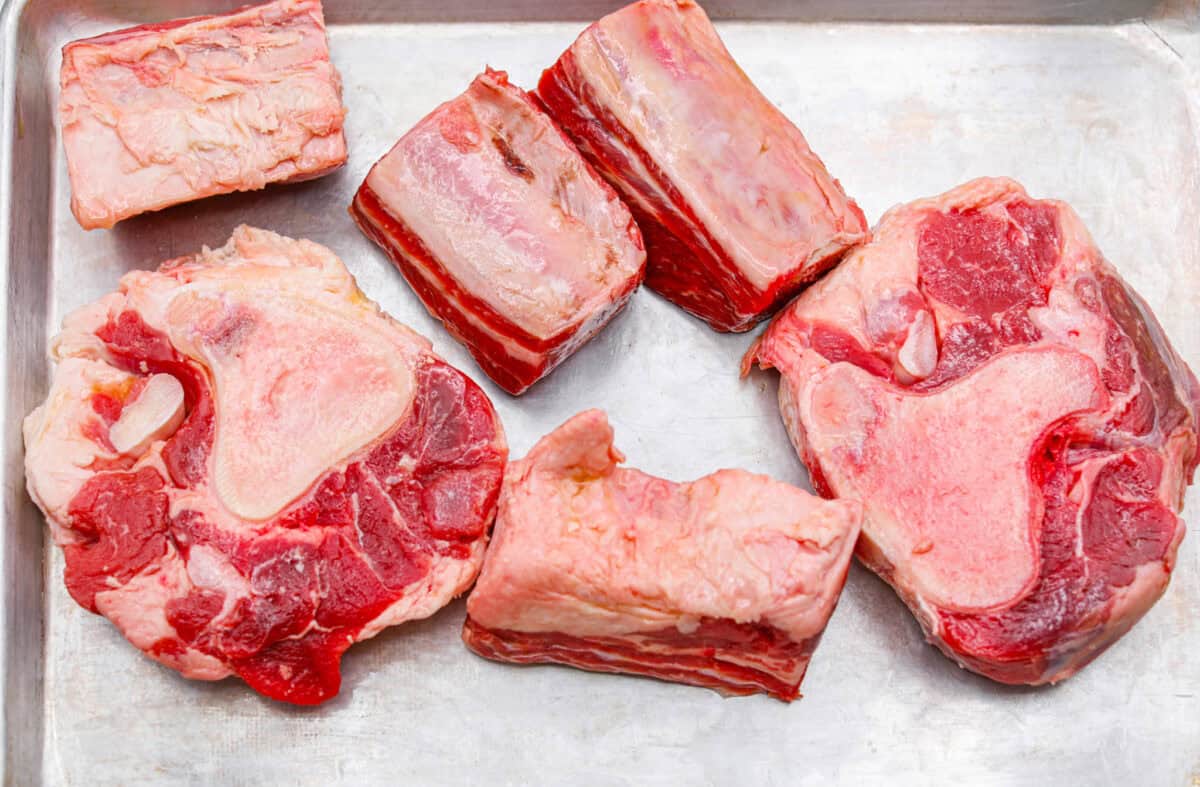
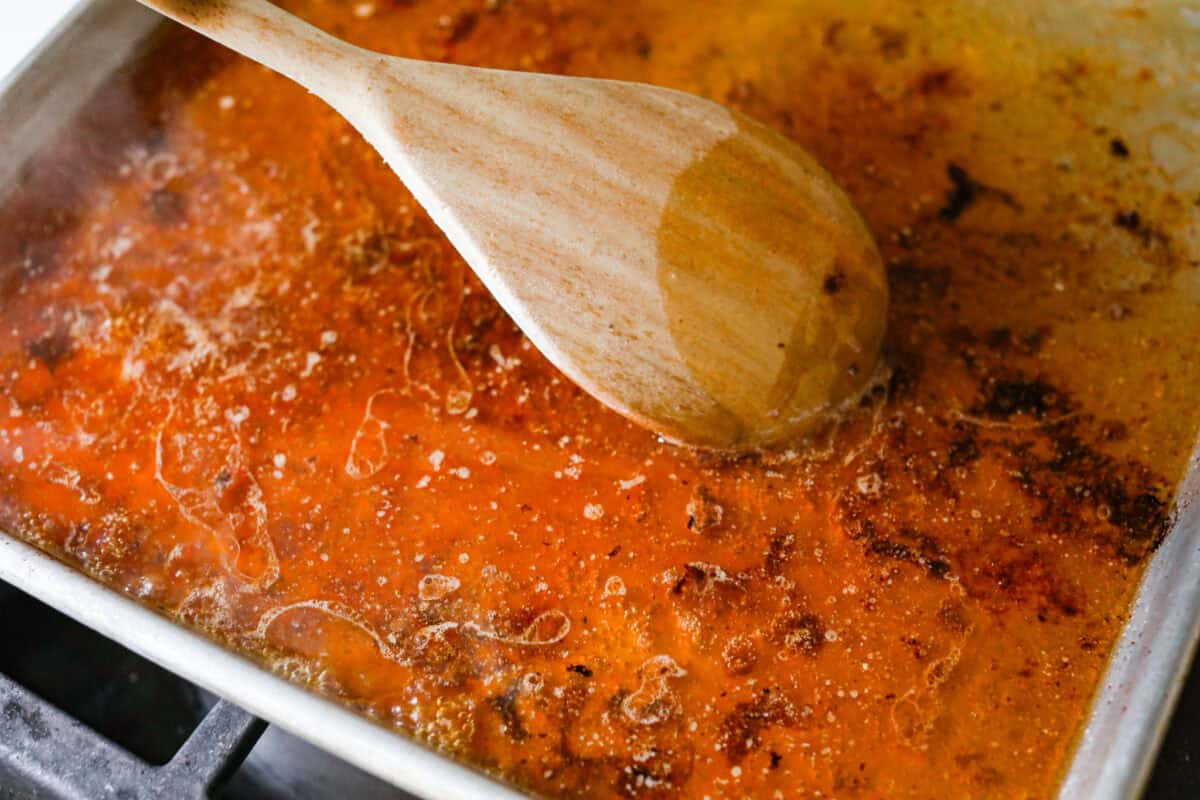
- Add: Add the beef drippings from the baking sheets to the stockpot, along with the onion, garlic, carrots, celery, parsley, thyme, bay leaves, peppercorns, and apple cider vinegar. Add cold water to the pot until the beef and vegetables are just barely submerged. Stir just a few times, then leave it alone. Too much stirring makes the broth cloudy. Bring to a boil over medium heat, then reduce to low and simmer uncovered for 8–24 hours for a deeper flavor. If the liquid drops below the meat and bones after 8 hours, add just enough cold water to keep them covered without diluting the broth.
- Skim the Scum: Skim the scum that rises to the surface of the broth a few times during cooking. Don’t stir it, or the broth will become cloudy!
- Strain: When the broth is done simmering, strain the solids through a colander and let them drain for 5–10 minutes without pressing (pressing makes the broth cloudy). Discard the solids, then strain again through a fine-mesh sieve lined with cheesecloth for an extra-clear broth. (You can do this 2-3 times) Pour the broth into a large container, cool to room temperature, then cover and refrigerate. After chilling homemade beef broth overnight, scoop off and discard the solid fat layer. If your broth yields more than 1.5 quarts or tastes mild, simmer over low heat to reduce and concentrate the flavor (optional).

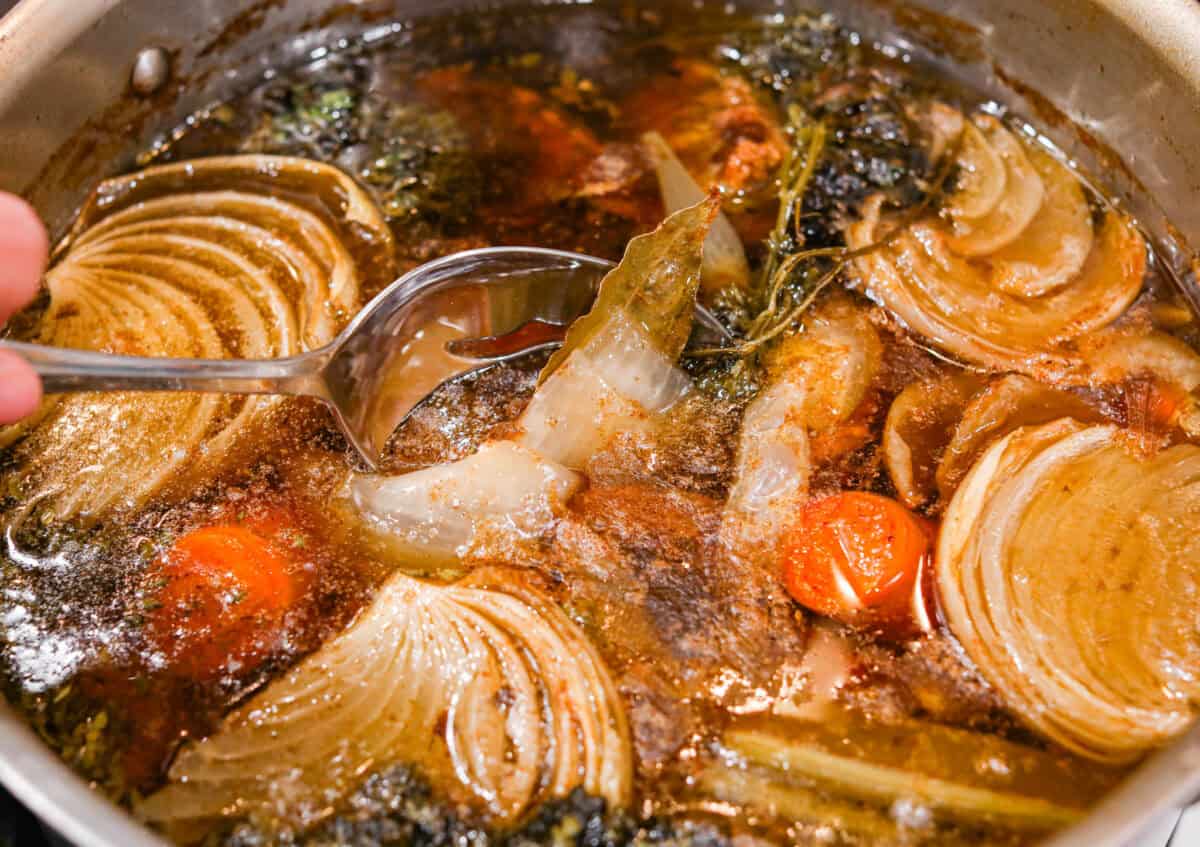
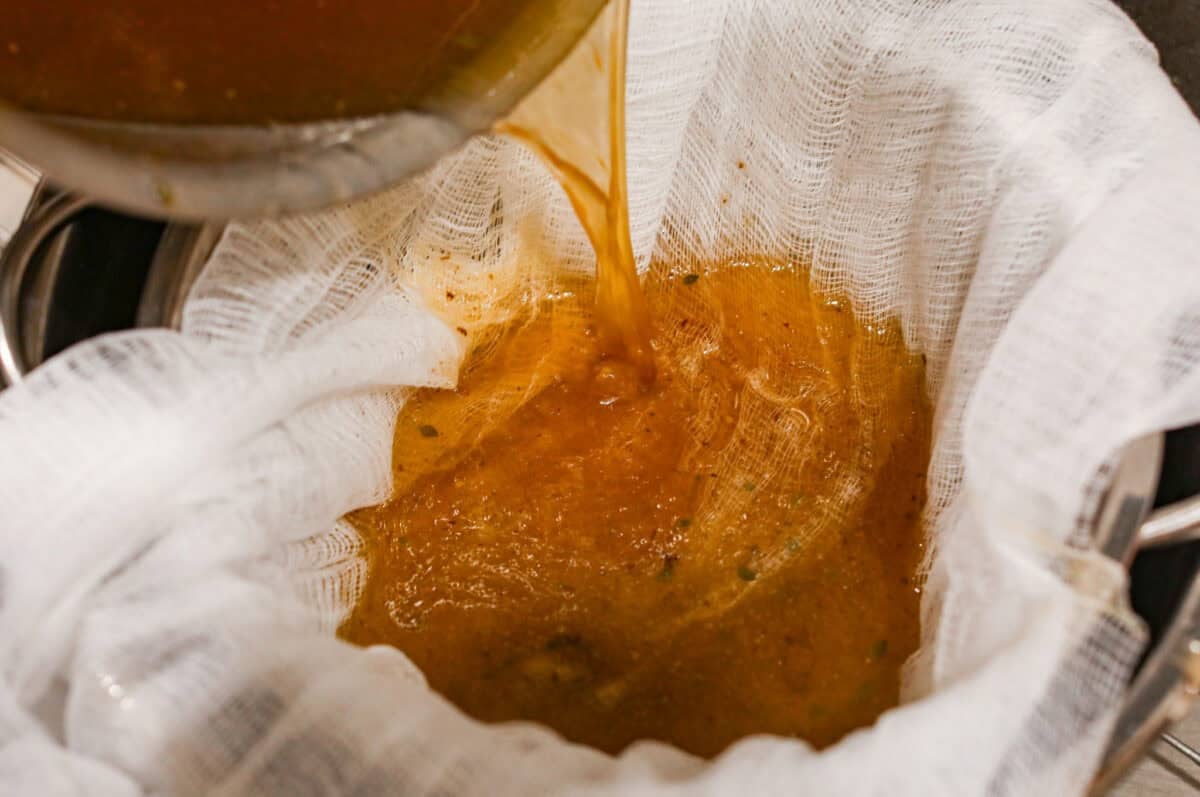
Alyssa’s Pro Tip
Homemade Bouillon: Simmer broth until reduced to 2–3 cups, cool, pour into ice cube trays, and freeze. Add a cube to sauces or soups for an instant flavor boost.
Slow Cooker Directions
- Add ingredients: Place roasted bones and beef in a 6–7 quart slow cooker.
- Add aromatics: Include the vegetables, herbs, and vinegar.
- Cover: Pour in cold water until the bones and beef are just barely submerged.
- Cook: Set to LOW for 8–10 hours, skimming any foam that rises a couple of times.
- Finish: Strain and reduce as directed in the recipe card.
Pin this now to find it later
1 large 8-10 quart stockpot
- ▢ 5 pounds meaty beef bones
- ▢ 2 tablespoons olive oil
- ▢ 1 large onion peeled and chopped into large chunks
- ▢ 6 cloves garlic lightly smashed, skin on or off
- ▢ 1-2 large carrots chopped into large chunks
- ▢ 1-2 celery ribs chopped into large chunks with the leaves removed
- ▢ 10 sprigs fresh parsley
- ▢ 3 sprigs fresh thyme
- ▢ 2 dried bay leaves
- ▢ 12 whole peppercorns
- ▢ 1 ½ tablespoons apple cider vinegar
- ▢ 6-7 quarts cold water more or less as necessary to just cover the bones
Preheat the oven to 425 degrees Fahrenheit. Spread out 5 pounds meaty beef bones evenly on two large baking sheets and drizzle with 2 tablespoons olive oil, rubbing the oil around to coat the meat.
Roast the beef for 1 hour, flipping at the 30-minute mark. Once roasted, add the beef to the bottom of a large, deep stockpot and add about ½-¾ cups of water to the baking sheets to deglaze them. If necessary, heat the pans on the stovetop over medium-low heat in order to scrap up all the beef drippings.
Add the beef drippings from the baking sheets, 1 large onion, 6 cloves garlic, 1-2 large carrots, 1-2 celery ribs, 10 sprigs fresh parsley, 3 sprigs fresh thyme, 2 dried bay leaves, 12 whole peppercorns, and 1 ½ tablespoons apple cider vinegar.
Add 6-7 quarts cold water to the pot, until the beef and vegetables are just barely submerged.
Bring to a boil over medium heat, before reducing the heat to low. Simmer uncovered for at least 8 hours, or up to 24 hours for more depth of flavor. If you cook the broth longer than 8 hours, you may want to add a little more cold water as it evaporates and exposes the meat and bones but avoid adding too much additional water as this will dilute the flavor of the broth.
A few times during the cooking process, skim the scum that rises to the top of the broth. Don't stir it, as this will make the broth cloudy!
Once the broth is done simmering, strain the solids with a colander and let them sit for 5-10 minutes in the colander to catch any drippings from them (don't press them! this will make the broth cloudy). Discard the solids and, if desired, strain the broth a second time through a fine mesh sieve lined with a few layers of cheesecloth.
Add the broth to a large container and let sit on the counter until cooled to room temperature, then cover and refrigerate.
After the broth has chilled overnight, scoop off the solidified fat from the top and discard. Once the fat has been removed, you may heat the broth on the stove over low heat and concentrate the flavor by simmering it until it has reduced to 1.5 quarts if it exceeds that amount, but this is optional.
Storing, Reheating, & Bouillon Making Instructions
- Refrigerate: Store beef broth in an airtight container for up to 7 days.
- Freeze: Freeze for up to 6 months in freezer-safe containers, ziplock bags, or silicone molds. Smaller portions (like ice cube trays) make it easy to use later.
- Texture: Chilled broth may gel—it’s rich in collagen! It melts quickly when reheated on the stove or in the microwave.
- Reheat: Warm gently over medium-low heat; avoid boiling to keep it clear.
- Bonus Tip: For homemade bouillon, simmer broth until reduced to 2–3 cups, cool, pour into ice cube trays, and freeze. Add a cube to sauces or soups for an instant flavor boost.
Calories: 54kcalCarbohydrates: 3gProtein: 0.4gFat: 5gSaturated Fat: 1gPolyunsaturated Fat: 1gMonounsaturated Fat: 3gSodium: 58mgPotassium: 72mgFiber: 1gSugar: 1gVitamin A: 2175IUVitamin C: 5mgCalcium: 44mgIron: 0.4mg
Nutrition information is automatically calculated, so should only be used as an approximation.

About Alyssa Rivers
Alyssa Rivers is the author of 'The Tried and True Cookbook', a professional food photographer and experienced recipe-developer. Having a passion for cooking, her tried and true recipes have been featured on Good Morning America, Today Food, Buzzfeed and more.












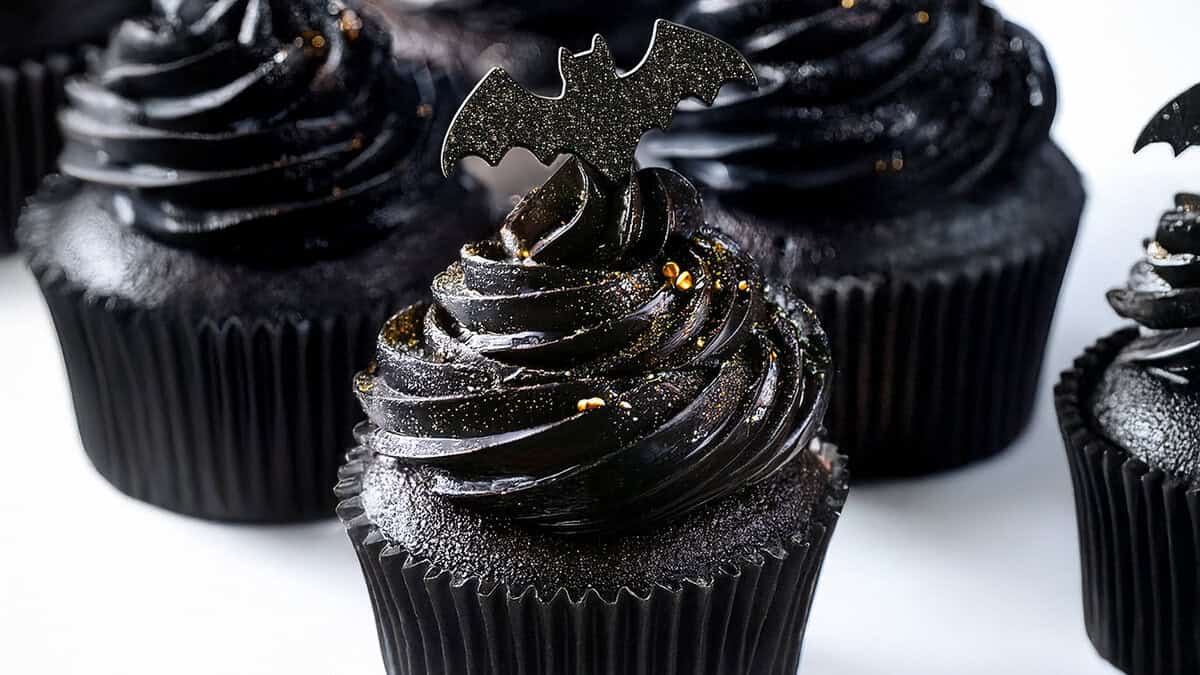

 English (US) ·
English (US) ·